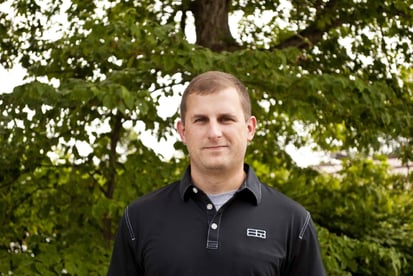Studying the performance of refrigerants is of our passions at SRC and we've invested heavily in learning as much as we can about them. Last week, ATMOsphere held their annual natural refrigerants conference in Washington D.C. The conference took place on June 7th and 8th and Super Radiator Coils sent three engineers to learn about the natural refrigerant market, emerging applications, new technologies, and more. Read below to hear what SRC's Ken Allen, Will Klick, and Gail Miller took away from the conference and their thoughts on the future of natural refrigerants.
According to those in attendance, one of the most notable takeaways from the conference was the turnout. The two-day conference featured 39 speakers, 35 sponsors & partners, and was attended by representatives from more than 125 organizations. In addition to the robust attendance, ATMOsphere CEO Marc Chasserot said the day’s events reflected a change in mentality among HVAC-R and adjacent industries.
“After 10 years, I feel that there is a ‘mindset’ change.,” Chasserot said in a press release. “It’s no longer about ‘whether’ but now about ‘how’ and ‘faster please.’ Natural refrigerants are daily business now for many companies in the U.S.”
Gail, Ken, and Will said they left the conference with similar sentiments.
Gail's takeaways
 "Overall, the conference was a great learning opportunity. It was awesome to be able to talk with some really smart people about types of natural refrigerants, applications currently utilizing natural refrigerants, and case studies underlining the importance of increasing the adoption of these refrigerants here in the United States.
"Overall, the conference was a great learning opportunity. It was awesome to be able to talk with some really smart people about types of natural refrigerants, applications currently utilizing natural refrigerants, and case studies underlining the importance of increasing the adoption of these refrigerants here in the United States.
When you can engineer products that satisfy the customer and reduce our impact on our environment, I just think that's great. That was probably my biggest takeaway - the ability to observe numerous companies supporting net-zero initiatives and pushing practices that are better for our planet.
An interesting topic that stuck with me was “Fluorinated Refrigerants as PFAS” and their impact on our health and safety. As consumers, most of us have been introduced to the rising issue of micro-plastics in our environment. Fluorinated refrigerants are PFAS and considered “forever chemicals”, and like single use plastics, PFAS take prolonged periods of time to decompose. This has led to trace amount of PFAS being detected in our drinking water. The struggle then becomes how to regulate and/or eliminate the use of fluorinated refrigerants."
Ken's takeaways
 "I thought the attendance was quite large, especially given that we're still coming out of the pandemic. There was a good deal of talk about what was actually happening in the world of CO2, not just what people and companies thought. ATMOsphere always does a good job of presenting facts and figures about adoption trends, which I've always found to be useful information.
"I thought the attendance was quite large, especially given that we're still coming out of the pandemic. There was a good deal of talk about what was actually happening in the world of CO2, not just what people and companies thought. ATMOsphere always does a good job of presenting facts and figures about adoption trends, which I've always found to be useful information.
I think one of the coolest things about the conference is that it helped me really get a feel for exactly where the US CO2 market is today. In the six years or so since I started attending, this has gone from what is possible and what they are doing in Europe to how many installations we have in the US. It's been awesome to see CO2's usage take off stateside and I think that number's only going to keep increasing.
As far as some specific application, heat pumps and water heaters were definitely hot topics. In some parts of the US, new natural gas connections for water heating have been prohibited. And electric resistance water heaters are not very efficient, when compared to the COP of a heat pump. These are common in Japan and Europe, but not in the US. So, I think we'll start seeing CO2 heat pumps and water heaters really start to come into their own in the United States."
Will's takeaways
 "For me, it was great to see how much interest there is in natural refrigerants, and rightly so. The HVAC-R world is definitely experiencing a reckoning. Regulations designed to phase out the production and usage of environmentally harmful refrigerants are doing what they were intended to do, and there's been significant investment in new technologies and other innovations in the natural refrigerants space. I really believe that the future is natural.
"For me, it was great to see how much interest there is in natural refrigerants, and rightly so. The HVAC-R world is definitely experiencing a reckoning. Regulations designed to phase out the production and usage of environmentally harmful refrigerants are doing what they were intended to do, and there's been significant investment in new technologies and other innovations in the natural refrigerants space. I really believe that the future is natural.
Europe has seen drastic increases of the last 10 years in the use of natural refrigerants, particularly, R744 (CO2) and R290 (propane) on both the commercial and even the residential sides, with over 40,000 systems installed. While the North American market is about 10 years behind Europe. There's no doubt the demand is growing, with currently around 900 systems in operation with several hundred more in planning and production.
The ATMOsphere conference earlier this month was also a great forum to chat with customers and others industry professionals about where they see the industry heading as far as natural refrigerants are concerned. Like Ken, I heard a lot of talk about water heaters, too. CO2 heat pumps were definitely a hot topic, too. I think the future is bright and it was great to spend time with likeminded individuals who are passionate about thermodynamics and mechanical engineering and realize that HVAC-R equipment can be effective while also being less impactful on the world we live in."
If you're exploring a switch to CO2 and have questions about how that could impact the design of your heat transfer equipment, get in touch with us. We can help you get a better understanding for CO2 coil performance, materials best practice, heat reclaim opportunities, and more. And feel free to check out our coil selection software, Enterprise, if you're interested in running some CO2 selections.
Don’t get left out in the cold when it comes to heat transfer information. To stay up to date on a variety of topics on the subject, subscribe to The Super Blog, our technical blog, Doctor's Orders, and follow us on LinkedIn, Twitter, and YouTube.


 "Overall, the conference was a great learning opportunity. It was awesome to be able to talk with some really smart people about types of natural refrigerants, applications currently
"Overall, the conference was a great learning opportunity. It was awesome to be able to talk with some really smart people about types of natural refrigerants, applications currently 

